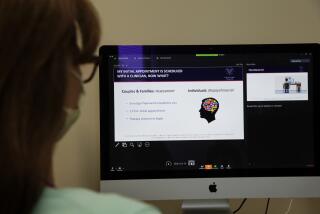Effect of call-based counseling ringing true
- Share via
The therapist-patient relationship is crucial to people battling depression, addiction, weight gain and diabetes. But that relationship might not always have to be in person to be effective.
Over the last decade, numerous hospitals and clinics have begun experimenting with telephone-based care to treat a litany of health problems — with surprising success. Now a new study has found that it can even ease the pain and depression of cancer patients.
“Telecare provides additional support to people and can help them feel included and part of something,” said Dr. Cynthia Lee Dennis, an associate professor of nursing at the University of Toronto who has studied the effect of telephone counseling in women with postpartum depression.
Such care can also be more convenient than actually going to a therapist’s office because the phone call can be scheduled for a time and place that’s convenient for the patient. “It can even help some people to speak more freely and feel more comfortably than they would in a normal face-to-face situation,” Dennis said.
A study published in the July 14 issue of the Journal of the American Medical Assn. found that cancer patients who talked regularly with a nurse over the phone and answered automated voice-recorded surveys about their symptoms experienced greater improvements in their pain and depression levels than patients who did not receive this additional care.
“Pain and depression are two of the most common symptoms in cancer patients, besides fatigue,” said Dr. Kurt Kroenke, lead author of the study and professor of medicine at Indiana University. “However, in a busy clinical setting, discussing issues like symptoms might be a secondary part of the visit, so it is often unmentioned and untreated.”
At the beginning of the 405-person study, 131 patients had depression (32%), 96 had cancer-related pain (24%) and 178 had both depression and pain (44%).
All patients were currently being treated for their cancer, but one group was given tele-care that focused on pain and depression; the other group received no such treatment. Over 12 months, tele-care patients received a total of 11 phone calls by a nurse and had a choice of receiving either 21 interactive voice-recorded calls or taking 21 online surveys asking them to rate their pain and depression levels. In addition to having a contact telephone number for the nurse, patients were also asked at the end of the automated phone calls or surveys if they would like a nurse to call them.
“The study was designed to develop a more efficient way of administering clinical care, but it also ended up substantially helping the patients with their pain and depression,” Kroenke said. The results are surprising, he said, especially given the fact that a majority of the treatment was administered by a voice recording or Internet survey and not a live nurse.
The automated calls were added to the study as a means of avoiding the missed calls, telephone tag and scheduling difficulties that are common when coordinating with nurses in traditional telephone-based care programs, Kroenke said, adding that the study was the first to use such calls as a way of treating patients.
“It is a weird twist on support programs,” said Dennis. “This study shows that patients can feel included and part of something even through an automated voice-mail system.”
Significantly greater improvements were seen in the pain and depression levels of the tele-care patients by the end of the study, with 57% of patients in the tele-care group reporting reduced levels of pain, compared with 43% of the usual-care patients.
Similar improvements were seen in the patients’ levels of depression. At the end of the 12-month study, the tele-care management group had less severe depressive symptoms at 12 months. Further, only 21% had major depression at the study’s end, compared with 35% of the usual-care group.
“The results show that a collaborative care approach is more effective than just designated management in which a physician counsels the patient,” said Kroenke.
Other telephone-based programs have shown similar results. In Dennis’ study, published in January 2009 in the British Medical Journal, researchers found that young mothers suffering from anxiety and postpartum depression were more likely to benefit from telephone-administered counseling than they were from standard postpartum care at a clinic.
And a study published in 2005 in the Archives of General Psychiatry found that telephone-based continuing care for alcohol- and drug-dependent outpatients helped more patients to stay clean and finish their treatment.
More recently, a study published in Behavior Therapy in June found that telephone psychotherapy sessions could help even patients with major depression; 42% of the 30 participants were considered recovered at the end of six months. That compares favorably to an estimated 50% recovery rate of in-person therapy. .
Some therapists, however, warn against relying too heavily on telephone-based care as an alternative to live therapy sessions. Without non-verbal clues, such as facial expressions or fidgeting, a therapist can have trouble reading patients’ emotions and might be more likely to misunderstand their needs and symptoms.
Kroenke, however, is confident of its potential. It “can be a great way to reach out and help more people, regardless of where they live, and can help physicians and nurses save time and money.”






